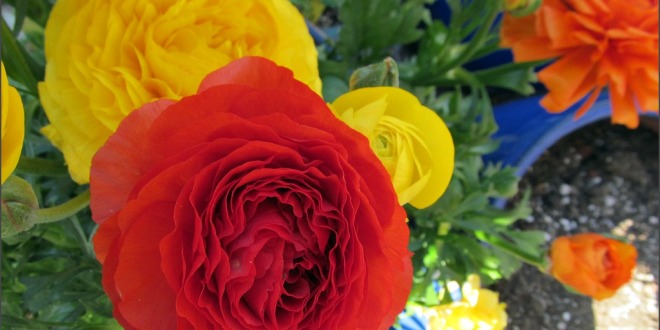Ranunculus are easy to grow and provide fresh cut flowers. Lots of colors, straight stems, long vase life and copious blooms. In return, these lacy-leafed plants will ask for sunshine, moderate temperatures and very light watering. Your borders and beds will look great, your office desk will sport fresh flowers for pennies and your neighbor will be by asking for your gardening secret.
There are ranunculus selectively bred for containers. More compact form, same incredible range of luscious shades, super-full flowers with petals overlapping petals. . . . now in a shorter size.
[/toggle]
”Outdoor
Site your ranunculus where they will receive full sun.
Dig holes and plant the ranunculus bulbs 2” deep and 4”-6” apart. The bulbs look like small, dark bunches of bananas, a curious shape that makes it easy to determine which side is up and which is down for planting. Tuck your ranunculus into the planting hole with the “bananas” pointing down.
After planting, water well to settle the soil around the bulbs. Roots and sprouts will form in the autumn. Winter will bring taller growth and flowers will develop in the spring.
When in bloom, feel free to cut ranunculus flowers for bouquets. This will not hurt your plants, in fact, the more you cut the more blooms your ranunculus will produce. Snip away.
After blooming has finished for the season leave the foliage in place; don’t cut it off. The leaves will gather sunlight and provide nourishment for next year’s show. Water as needed during active growth periods. Ranunculus actually prefer not to be watered while dormant.
At the end of the summer the leaves will yellow and die back as the plant slips into dormancy. Foliage many be removed at this point. Your ranunculus will rest for a few months before beginning the next growing cycle.
”Pots,
Site your ranunculus where they will receive full sun.
Dig holes and plant the ranunculus bulbs 2” deep and 4”-6” apart. The bulbs look like small, dark bunches of bananas, a curious shape that makes it easy to determine which side is up and which is down for planting. Tuck your ranunculus into the planting hole with the “bananas” pointing down.
After planting, water well to settle the soil around the bulbs. Roots and sprouts will form in the autumn. Winter will bring taller growth and flowers will develop in the spring. (Spring planted ranunculus will bloom the first year in late summer and in the spring subsequent years in frost-free areas.)
When in bloom, feel free to cut ranunculus flowers for bouquets. This will not hurt your plants, in fact, the more you cut the more blooms your Tecolote ranunculus will produce. So snip away.
After blooming has finished for the season leave the foliage in place; don’t cut it off. The leaves will gather sunlight and provide nourishment for next year’s show. Water as needed during active growth periods. Ranunculus actually prefer not to be watered while dormant.
At the end of the summer the leaves will yellow and die back as the plant slips into dormancy. Foliage many be removed at this point. Your ranunculus will rest for a few months before beginning the next growing cycle.
”Special
These banana-bunch looking bulbs are unusual in that they will hold well out of the ground for extended periods of time, sometimes more than a year. If you wish to hold your bulbs to plant at a later time – perhaps when weather is more suitable – simply tuck them in a brown paper bag and store them in a cool and dry environment. Warm, dry air may cause the bulbs to dry out and high humidity/excessive moisture may cause them to mold.
Ranunculus produce complex, multi-petal flowers and use a lot of energy doing so. To encourage strong flowering, add some all purpose fertilizer when you plant and suppliment with half strength fertilizer every two weeks while the plants are actively growing.








